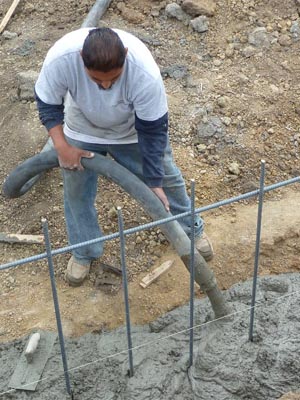Passive genocide
 We are slowly killing off our big animals. Since it is unpopular to mention this, our cowardly leaders will not mention it to avoid upsetting our voters; they, in turn, don’t want to hear about how their mundane acts may lead to vast and evil consequences.
We are slowly killing off our big animals. Since it is unpopular to mention this, our cowardly leaders will not mention it to avoid upsetting our voters; they, in turn, don’t want to hear about how their mundane acts may lead to vast and evil consequences.
After all, we all want the big suburban home, the aircraft carrier of an SUV, the endless stream of toys and gadgets and consumer entertainment products. Or at least, the vast majority do, so that those of us who do not are statistically insignificant.
For this reason, what I’m about to say is shocking — shockingly obvious, that is. Obvious both in its content and in why it is hidden away. It’s like talking about death at weddings or money at funerals.
A large black cat believed to be a panther is stalking the fields and forests of southern Tuscany, striking fear into residents and holidaymakers. Hunters have angered animal rights campaigners by offering to kill it, but the debate is academic — “Bagheera” is running rings around its pursuers.
{…}
What is to be done? Hunters say the dangerous animal should be driven out of the forest by beaters, and killed. Farmers say “give us guns, we’ll take care of it.” But animal welfare groups are up in arms at the suggestion, and have reminded the people of Prata that panthers are a protected species. They won’t even accept putting out live bait such as chickens or rabbits.
The controversy echoes the tale of Bruno the brown bear who wandered into Germany from Austria and eluded hunters for weeks, gorging himself on live sheep and honey, until he was shot dead, to the dismay of his many fans. – Der Spiegel
Wild animals are generally fearful of humans. Why would they come out?
For one thing, the easy chow is tempting.
More likely, however, they’re out of space to wander. Humans have pressed in on their territory, so they are heavily confined and looking for new spaces to roam.
Imagine being in solitary confinement for the rest of your life. Even if your cell was 100′ x 100′, it would still be seeing the same old stuff… every day.
Researchers have revealed results of a global camera trap study that has captured nearly 52,000 images. Camera traps placed in seven protected areas in the Americas, Africa and Asia have documented 105 species ranging from mice to elephants — and even varieties of humans from tourists to poachers. The study has also helped solidify reasons for mammal decline, including habitat encroachment and smaller wildlife reserves.
According to Conservation International, “Analysis of the photographic data has helped scientists confirm a key conclusion that until now, was understood through uncoordinated local study: habitat loss and smaller reserves have a direct and detrimental impact on the diversity and survival of mammal populations.” – Treehugger
For the last thirty years, the media has kept you on edge with talk of what discrete threats might eliminate animal species.
It’s always something that can be isolated from “life as usual,” like an optional or fringe behavior, or a single corporation or country.
They never state the obvious: constant human expansion on a finite planet means less room for plants, animals and ecosystems.
At some point, you confine them so much that like prisoners in solitary, they go numb and incoherent, and stop feeding themselves well.
And breeding. The demise of the species is then not far off.
And what happened to them was physical. EEG studies going back to the nineteen-sixties have shown diffuse slowing of brain waves in prisoners after a week or more of solitary confinement. In 1992, fifty-seven prisoners of war, released after an average of six months in detention camps in the former Yugoslavia, were examined using EEG-like tests. The recordings revealed brain abnormalities months afterward; the most severe were found in prisoners who had endured either head trauma sufficient to render them unconscious or, yes, solitary confinement. Without sustained social interaction, the human brain may become as impaired as one that has incurred a traumatic injury.
On December 4, 1991, Terry Anderson was released from captivity. He had been the last and the longest-held American hostage in Lebanon. I spoke to Keron Fletcher, a former British military psychiatrist who had been on the receiving team for Anderson and many other hostages, and followed them for years afterward. Initially, Fletcher said, everyone experiences the pure elation of being able to see and talk to people again, especially family and friends. They can’t get enough of other people, and talk almost non-stop for hours. They are optimistic and hopeful. But, afterward, normal sleeping and eating patterns prove difficult to reëstablish. Some have lost their sense of time. For weeks, they have trouble managing the sensations and emotional complexities of their freedom.
For the first few months after his release, Anderson said when I reached him by phone recently, “it was just kind of a fog.†– New Yorker
Like most conditions, this probably exists on a spectrum.
When you have enough space, you’re happy. But below that threshold, the alienation sets in — in proportion to how much space that you need which you do not have.
We are slowly forcing animals into corners. We are reducing them from wide-ranging, healthy creatures to confined, crowded and miserable ones (kind of like our cities).
The result is that at some point desperation sets in, and the animal rages out of its confinement. It probably knows on some level that it will die for this act.
As a result, the animals are getting bolder and more violent.
A DISTRAUGHT mother listened on a mobile phone as her teenage daughter was eaten alive by a brown bear and its three cubs.
Olga Moskalyova, 19, gave an horrific hour-long running commentary on her own death in three separate calls as the wild animals killed her.
She screamed: “Mum, the bear is eating me! Mum, it’s such agony. Mum, help!’†– The Express
The comic dimensions of such a protracted miserable death aside, we can see how the hopelessness of woodland creatures leads them to become more vicious.
They have nothing to lose.
And we refuse to talk about what is surely the cause, and will be the cause of their demise as species. It’s passive genocide: we just keep expanding, and denying that a problem exists, and if the animals attack us, we kill them. Someday they just vanish and we assume they just weren’t competitive, or something.
It gets mentioned rarely, and never as the headline of the article. Our passive aggression against plants and animals motivates us to think first of human losses, and only secondarily to care in any way about what we’re destroying.
We never think, “Are all these new humans good people?” — instead, we treat every life as sacred. Every person must be important. Or at least more important than all those animals we are exterminating.
The double killing is the latest in a spate of bear attacks across ÂRussia, as the hungry animals seek food in areas where people have Âencroached and settled on their former habitat.
If you make the truth inconvenient, and make sure there is zero social reward for it, most people will ignore it. They will assume that someone else will take care of it, since we have this vast society with people whose jobs involve worrying about these things.
But those people cannot help. The solution concerns the whole of humanity: we must limit and reduce our growth. That is however an unpopular topic, because that means that not everyone gets to live the dream, or even live. It forces us to make hard decisions about which people we value and which we do not.
As a result, we avoid dealing with it, and our passive genocide against the creatures continues.









